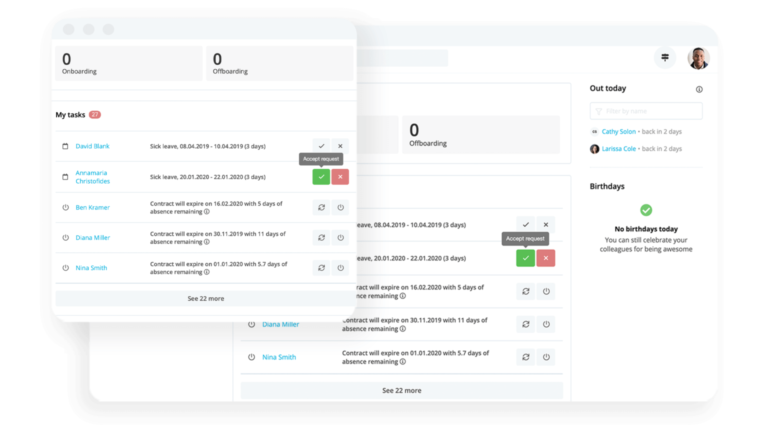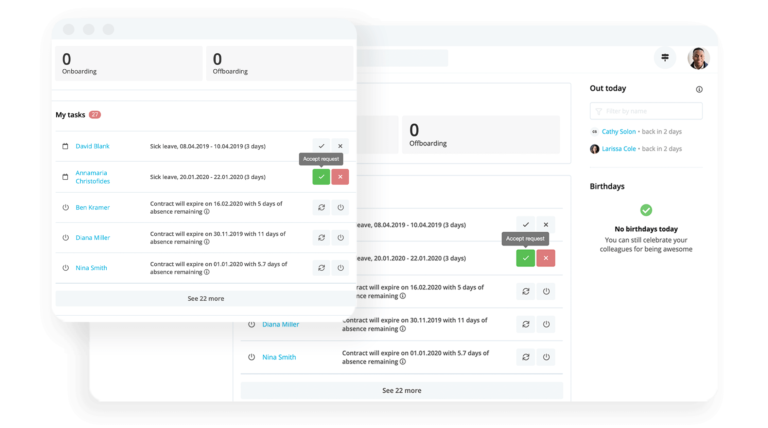14. March 2022
How To Convince Your CEO That You Need HR Software

Let's start with the good news: Research from Accenture has found that 89% of CEOs think HR should have a central role in their business. That's great news for HR teams who want and deserve a permanent seat at the executive table.
But, great expectations do not come with a blank cheque.
Many CEOs will expect more from their HR function, and place pressure on making the most of their time. As an HR leader, you may need to convince your CEO that investments, like HR software, are well worth everyone's time. Here's how you can do it.
Book a demo to see why 15,000 companies trust Personio with their HR work.The Frustrations of Manual HR Processes
Let's start by considering the life of your typical HR manager: let's call her Hannah.
Hannah uses spreadsheets and a random assortment of tools to manage her everyday tasks. Most of her day is spent chasing colleagues, haranguing line managers for details or simply checking that the right data is in the right place.
The result is, as you might expect, frustrating. And, the thought of going to the CEO and making an argument for HR software? Even more frustrating. Too many times, she’s been told that it isn’t necessary or it isn’t a current priority.
Sound familiar? If you feel Hannah's pain, chances are you know that using HR software would help both you and the company to simplify processes.
But for the CEO, HR is simply not a priority. Unfortunately, we hear this too often from our own customers. So, we put together this guide to help you persuade your CEO with some of the top benefits of HR software for just about any business.
Understanding Your Typical CEO
As an HR professional, it helps to start by putting yourself in the CEO's shoes. Start by considering what makes them tick and how to account for their unique needs.
An average CEO may have the following desires or disinterests:
They do not want to be bothered with HR details or administrative challenges.
They want to ensure that the company’s future is secure, which means cutting costs, increasing efficiency, and avoiding any legal risks.
They want more revenue and, to achieve this, need the ‘right’ (in other words, efficient, productive and loyal) employees.
Do you think your existing HR processes are jeopardising any of this mix?
If so, be open about this and tell them – that is the only way you will get them to listen. What they do not want are: additional costs, legal risks and erroneous reporting that can easily lead to bad decisions being made.
What Information Do You Need Before Speaking with Your CEO?
As we mentioned earlier, CEOs see HR has central to business. But, they may be a bit less clear on how better processes underpin that centrality.
The fact is that without the proper processes and the right software to support them, it will not be possible to attain your organisation's goals.
Take this argument and run with it. Where do the problems lie? What are the goals that you want to achieve, and what do you need in order to succeed?
Average Problems for HR Departments
Essentially, your problems are not the same as your CEO's problems. So, you need to find a way to 'draw a line' between the key issues in your HR department, and how they can have a detrimental impact on your business's bottom line.
The following will help you identify and formulate your own problems. In order to make the seriousness of the situation as clear as possible for your CEO, you need to provide specific figures and examples for each argument:
Problem One: Growth is slowing down because we can't recruit fast enough. We've only filled 'X' amount of positions in 'Y' time.
Problem Two: In the past quarter, 'X' applicants have turned us down because our recruiting process takes too long or because they don't see us as an attractive employer.
Problem Three: We are currently not in compliance with data protection standards of regulations.
Problem Four: Our attrition rate is too high because employees have become dissatisfied with cumbersome processes (like performance review cycles).
Problem Five: Our HR processes take away time from our employees, hindering their own productivity and increasing dissatisfaction levels.
Problem Six: With no reliable reporting and analytics, we can't anticipate any issues with turnover over headcount before they happen.
Turning Problems Into Arguments for HR Software
How can software solve your business problems? Make it clear that this software will not only benefit HR, but will also have a positive impact on corporate goals.
For instance, by boosting sales if employees can be recruited faster, work more productively and are able to develop professionally.
Consider some of the following to help:
Problem | Potential Solution |
|---|---|
Growth is slowing down because we can't recruit fast enough. We've only filled 'X' amount of positions in 'Y' time. | Using HR software, we can streamline our recruitment processes so efficiently that our hiring targets can be achieved with the current staff we have on hand. |
In the past quarter, 'X' applicants have turned us down because our recruiting process takes too long or because they don't see us as an attractive employer. | Using HR software, we would be able to send automatic confirmation of receipt of applications and also be able to speed up the internal coordination process. |
We are currently not in compliance with data protection standards of regulations. | HR software would allow us to better monitor/delete/anonymise data and avoid legal penalties or issues. |
Our attrition rate is too high because employees have become dissatisfied with cumbersome processes (like performance review cycles). | HR software can result in up to 66.66% time savings for HR teams -- time that could be re-invested into developing retention programmes. |
Our HR processes take away time from our employees, hindering their own productivity and increasing dissatisfaction levels. | HR software would reduce the amount of time staff and management spend on personnel administration and recruiting by 50%. |
With no reliable reporting and analytics, we can't anticipate any issues with turnover over headcount before they happen. | Reliable reporting gives us an overview of staffing projections, salary structure and other relevant KPIs. |
Outlining the Resources Required
A number of stakeholders may need to be involved in the software implementation process.
This should be communicated to management right from the start in order to avoid surprises down the road.
For a four-week implementation, all of the staff involved will need to work a combined total of 40 hours per week on the project.
Personnel & Points of Contact
It helps to address who would be involved in any type of implementation project. Provided is a quick example to help you guide the conversation:
HR (ideally two people):
A project manager, who will coordinate processes with the software provider and serve as the resource person for the program.
Possibly also some additional assistance, e.g. a student trainee, to gather the required data.
IT: to provide implementation support
Legal: to verify the contractual terms
Data Protection Officer: to ensure data protection compliance
Contact persons in the individual departments: to provide internal communications support
Questions on Costs
"How much is this all going to cost?"
This question is guaranteed to come up. Remember: For your CEO, cost reduction (or, at the very least, cost consciousness) is the goal.
Be prepared to do more than simply lay out the software costs: Present the long-term savings that will be achieved by using the software as well.
Visit Personio's pricing page for a real-time example.
Bottom Line: What Can Personio Do For You?
Note: The following calculation is based on experience we’ve gained in working with over 1,000 clients. Your results may be different, since we cannot guarantee that the numbers will apply 1:1 to your situation.
A Key Argument: Saving Money Through HR
The cost of any HR software or solution must be weighed against the return on investment, consisting of the savings achieved in administration, in the optimisation of employee recruitment and opportunity gains.
Let's talk you through each...
1. Admin Savings
There is enormous potential for savings in the administrative area.
For many customers, we find that they can reduce administrative workloads by 30-35%.
In the example above, we assume that HR will be able to reduce costs by 25% annually.
Other employees, calculated in the example at an average hourly wage of €25, would save 30 minutes of working time per month, resulting in a total savings of €30,000.
2. Process Optimisation
Take recruiting for instance. Modern recruiting solutions can help you to attract an increased number of applications or to invest more quality time on applications you receive.
For instance, clients have reported that the number of applications received has risen by 100-200%, but still without necessitating additional staff.
Note: In the example above, empirical values were used for the amount given (€32,995).
3. Opportunity Gains
An HR solution should allow you to optimise standard processes, such as onboarding or employee development. This helps increase employee satisfaction, which has a positive effect on turnover.
Studies have shown that each time an employee leaves, the cost to the company is €43,069. For every three employees the company is able to retain, there is therefore a savings of € 129,207.
15,000 organisations trust Personio for this reason

Just like LUSH and Premier Inn, trust Personio's all-in-one HRIS to upgrade your people operations for now and into the future. Click below to learn more about us.
Book Your DemoWhat Is Your CEO Likely to Ask You?
Here are some of the key questions that a CEO may ask about HR software...
"Why Introduce a Software Program Now?"
It’s very simple: Because, using HR software will actually result in cost savings. In the example above, you would have invested €27,909 in software, but the return would be six times as much: €176,602.
Looking at it from the opposite perspective, if you do not implement software now, you will lose out on the annual savings on administration costs and those that would result from optimised employee recruitment, as well as on lost opportunity gains, totaling €217,202 per year.
Keep in mind: Software not only saves you and your colleagues time spent on administrative processes. It also gives you the resources you need to handle such issues as employee retention and development.
Steering A Conversation Around HR Software
An initial conversation is not going to be enough to convince your CEO to invest in HR software outright. But, you can at least get the conversation started and steer it in the right direction.
What’s important is that you don’t allow the conversation to end without getting a result. After all, you want your CEO to continue to think about implementing this type of software to help your business.
Encourage them to pin down definitive and actionable next steps:
When can you get together again for a follow-up meeting?
What information do they need, and by when?
What are the other obstacles to software implementation?
How can you help to remove these stumbling blocks?


